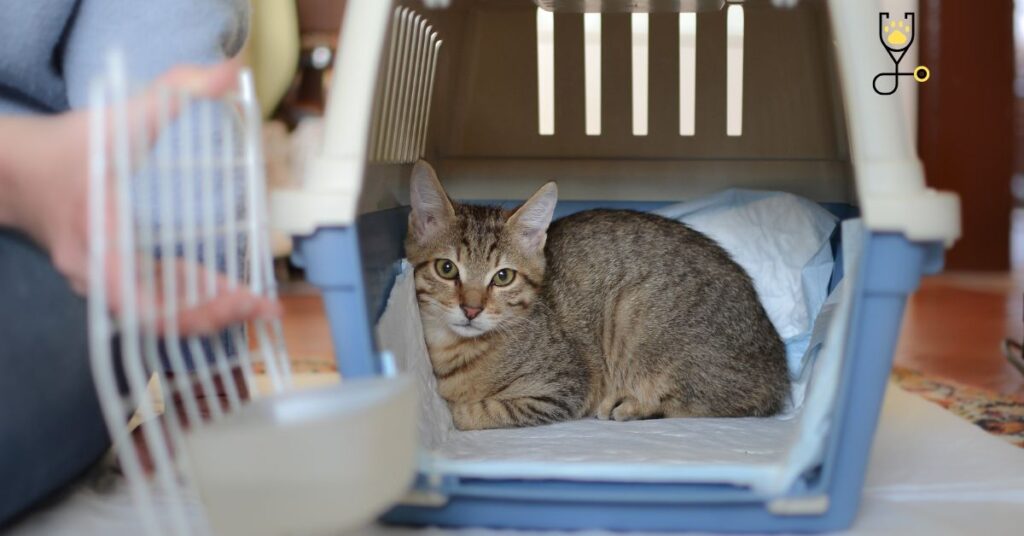Are you a cat lover who is about to move? If so, you may be wondering how to move your cat with you. Millions of cats are moved each year in the United States, and many of them experience constipation as a result. In this blog post, we’ll tell you everything you need to know about moving with a cat and preventing constipation. Keep reading for tips on how to make your next move easier for both you and your feline friend!
Before adjusting to the new home
-Create a safe haven: Set up an easily accessible litter box, food, and water bowl in a quiet room. Place your cat’s bed, toy box, and scratching post in the room as well. Add a few feline pheromone diffusers to help your cat feel relaxed and comfortable.
-Make sure all escape routes are blocked: Inspect your home thoroughly for potential escape routes. Your cat will be exploring their new home and you don’t want them getting out and getting lost.
-Keep them indoors: For at least the first week or two, keep your cat indoors. This will help them get adjusted to their new surroundings and prevent them from running away.

-Give them time to adjust: It takes cats a while to adjust to change. Be patient and give them time to explore and get comfortable in their new home.
-Monitor their eating and bathroom habits: Pay close attention to your cat’s eating and bathroom habits. If they stop eating or begin having accidents outside of the litter box, this could be a sign of stress.
-Introduce them to other pets slowly: If you have other pets in your home, introduce them to your cat slowly. Allow them to sniff each other under the door before letting them meet face-to-face. Supervise all interactions between pets until you are sure they get along.
During the adjustment
-Keep them in a carrier: It is best to keep your cat in a carrier during the move. This will help reduce their stress levels and keep them safe.
-Make sure the carrier is comfortable: Before the move, place your cat in its carrier and let them get used to it. Make sure the carrier is large enough for them to move around in and that it has a soft bedding material.

-Pheromones can help: Feliway® is a synthetic copy of the feline facial pheromone, which is used to calm cats in stressful situations. Try diffusing Feliway® in your home a few days before and during the move.
-Make sure they have food and water: During the move, make sure your cat has access to food and water. If possible, pack their food and water bowls in an easily accessible place.
-Limit their exposure to noise and commotion: During the move, limit your cat’s exposure to noise and commotion. Keep them in a quiet room away from the hustle and bustle.
-Give them plenty of breaks: Take breaks during the move so your cat can stretch their legs and use the restroom.
After you move
-Create a routine: Once you’ve settled into your new home, create a routine for your cat. Feed them at the same time each day and take them out for regular bathroom breaks.
-Make sure they have everything they need: Once you’re settled in, check to make sure your cat has everything they need – a litter box, food and water bowl, bedding, toys, etc.
-Monitor their eating and bathroom habits: Pay close attention to your cat’s eating and bathroom habits. If they stop eating or begin having accidents outside of the litter box, this could be a sign of stress.
-Give them time to adjust: It takes cats a while to adjust to change. Be patient and give them time to explore and get comfortable in their new home.

Moving with a cat can be stressful, but it doesn’t have to be. With a little planning and preparation, you can make the move easier for both you and your feline friend. Just remember to take things slowly, create a routine and be patient. Soon enough, your cat will be settling into their new home like it never left!
Conclusion
Moving with a cat can be stressful, but it doesn’t have to be. With a little planning and preparation, you can make the move easier for both you and your feline friend. Just remember to take things slowly, create a routine and be patient. Soon enough, your cat will be settling into their new home like it never left!
Frequently Asked Questions
Q: Can I give my cat medicine to help them adjust to the move?
A: You should speak with your veterinarian before giving your cat any medication. They can help you determine if medication is right for your cat and, if so, what type of medication is best.
Q: How long does it take for a cat to adjust to a new home?
A: It varies from cat to cat, but it generally takes a few weeks for a cat to fully adjust to their new home.
Q: What are some signs that my cat is stressed?
A: Some common signs of stress in cats include changes in eating or bathroom habits, increased vocalization, hiding, and aggression. If you notice any of these changes in your cat, speak with your veterinarian.
Q: What should I do if my cat runs away after we move?
A: If your cat runs away, the best thing to do is to call your local animal shelters and veterinary clinics. They may have seen your cat or be able to help you find them. You can also put up lost posters in your neighborhood and check online lost and found pet databases.
Q: I’m moving to a new home and my cat is getting old. Should I bring them with me?
A: Ultimately, the decision of whether or not to move with your elderly cat is up to you. If your cat is in good health and you think it would adjust well to the move, then there’s no reason why it shouldn’t come with you. However, if your cat is not in good health or you’re not sure how they would handle the move, it might be best to leave them behind. Speak with your veterinarian for guidance on what is best for your cat.







